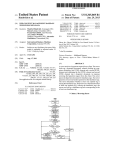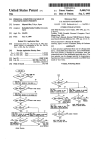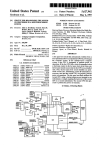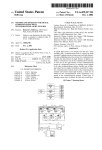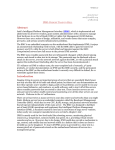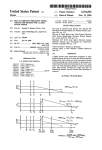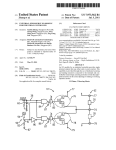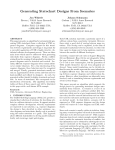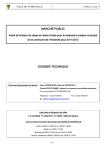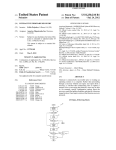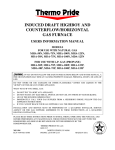Download DESIGNATED REGISTER \20
Transcript
US00564249 1A Ulllted States Patent [19] [11] Patent Number: Rose et al. [45] [54] Date of Patent: 5,642,491 Jun. 24, 1997 METHOD FOR EXPANDING ADDRESSABLE 5,193,161 3/1993 Bealkowski et a1. ................. .. 395/416 MEMORY RANGE 1N REALMODE 5,210,873 5/1993 Gay et a1. PROCESSING To FACILITATE LOADING OF LARGE PROGRAMS INTO HIGH 5,255,379 10/1993 Melo .... .. 395/412 5,303,378 4/1994 Cohen ................................... .. 395/700 MEMORY 395/650 OTHER PUBLICATIONS [75] Inventors: Robert Allen Rose, Delray Beach; Chappell, Geoff. DOS Internals, chapter 8, “Extended Allen Chester Wynn, Lantana, both of F1 . a Memory Access From Real Mode”. pp. 355-385. Jan. 1994. Primary Examiner—Jack A. Lane [73] Assignee: International Business Machines Assistant Examiner-Kevin Verbrugge Corporation, Armonk, NY, _ Attorney, Agent, or Firm—JefErey S. LaBaw; Dav1d H. Judson [21] Appl. No.2 309,862 [22] Filed: [51] [52] [57] SeP' 21’ 1994 Disclosed is a technique for overcoming the l-Mbyte mode Int. Cl.6 .................................................... .. G06F 12/06 ” 395/402, 395/570 [58] Fi dd of Search 3 95/1/00 425 570_ 364/206 """"""""""" ’ ’ memory 199M109 aswciatcd with ‘Teal-19°93” opm'ion of certain Intel Corp. microprocessor architectures. This limi tation can be overcome by altering the contents of a register port1on that is computationally meaningful only in “pro tected mode,” but which persists and exerts effects in real . References Clted [56] ABSTRACT U.S. PATENT DOCUMENTS 4825 358 4,1989 Letwin 5,027,273 6/1991 Letwin ........ .. 395,700 5,134,580 5,144,551 7/1992 9/1992 Bertram Cepulis et ................................. a1. .. 395/490 mode. By indirectly manipulating the contents of this reg ister portion in protected mode in a manner that avoids disruption to the register during the switch back to real mode, access can be obtained, in real mode, to up to 4 Gbytes °fv°1am° memory‘ 18 Claims, 1 Drawing Sheet CREATE GLOBAL f12 DESCRIPTOR TABLE 1 SWITCH 1o PROTECTED MODE /14 1 LOAD SEGMENT REGISTER /16 ' i SWITCH TO REAL MODE \ 18 i ACCESS MEMORY usmc DESIGNATED REGISTER \20 22 US. Patent Jun. 24, 1997 cREATE GLOBAL 5,642,491 /12 DESCRIPTOR TABLE D SWITCH TO /14 PROTECTED MoDE Jr LOAD SEGMENT fTs REGISTER J, SWITCH To REAL MODE \T8 ACCESS MEMORY USING DESIGNATED REGISTER \20 @22 5,642,491 1 2 METHOD FOR EXPANDING ADDRESSABLE MEMORY RANGE 1N REAL-MODE PROCESSING TO FACILITATE LOADING OF LARGE PROGRAMS INTO HIGH MEMORY tor table that de?nes a memory segment in terms of its physical location and length in bytes. This arrangement facilitates relocation of segments to different portions of memory by mere alteration of entries in the descriptor tables. Each descriptor table is an array of 8-byte entries called “descriptors.” The segment selector identi?es a segment FIELD OF THE INVENTION This invention relates to methods and apparatus for oper ating a computer system that utilizes a processor capable of operation in so-called “protected” and “real” modes. descriptor by specifying a particular descriptor table and a descriptor Within that table. The descriptor, in turn, speci?es the base or starting location of the segment in physical 10 memory. The use of different descriptor tables serves to isolate simultaneously running programs from one another BACKGROUND OF THE INVENTION while allowing them to access common resources in The “brain” of any personal computer is a microprocessor chip, which performs the functions once associated with memory. Programs running under an enhanced x86 micro processor specify either a Global Descriptor Table (GDT), which speci?es system-wide procedures and data that are dedicated hardware central-processing units. Microproces available to all active programs; or a Local Descriptor Table sors are generally organized into two functional areas: the (LDT) corresponding to the particular program being run. arithmetic/logic unit (ALU) and the control section. The control section obtains instructions from memory and con verts them into electronic signals that effectuate the opera tions they specify. These operations can involve the ALU or, Via a bidirectional system bus, extend to every function and Unlike the GDT, LDTs address memory locations that are 20 substantial number of programs Written for the 8086 were in widespread use when Intel introduced the 80286. In order to device associated with the computer. ' A popular family of microprocessors used in personal computers is manufactured by Intel Corporation, Santa 25 Clara, Calif. The internal architecture of these microprocessors, known generally by the designation “x86,” has undergone signi?cant evolution since the line was ?rst permit this body of programs to operate on enhanced x86 architectures, Intel designed these architectures to run in two modes. In “real address” or simply “real” mode, the micro processor emulates the 8086, treating a memory address as corresponding directly to a physical memory location within the l-Mbyte limit. In “protected” mode, the microprocessor introduced. The earliest x86 chips (the 8088, 8088-2, 8086 and 80186, hereafter collectively referred to as “8086” due to their similar attributes) were relatively limited in capa separately masked for each program. Because of the popularity of the x86 architecture, a treats an address as a segment selector, implementing the 30 memory-relocation and masking features that characterize the enhanced x86 architecture. The microprocessor can be switched from real mode to protected mode with a single instruction. bility. 8086 microprocessors did not support “multitasking,” i.e., the ability of a single computer to run more than one application at a time or to run background operations while This operational ?exibility is important, because real other tasks are carried out. Also, the 8086 could only address 35 mode processing can prove necessary even outside the a single Megabyte (Mbyte) of random-access memory context of older programs. In particular, before the operating (RAM)—adequate by then-prevailing standards but far too system and appropriate device drivers are loaded during limited to run today’ s software. The 8086 addressed memory bytes in terms of their “real” or physical addresses in RAM. Speci?cally, an address was speci?ed by a 32-bit pointer having two components: a 16-bit “segment selector” that speci?ed the starting address of a sequential series of bytes (a “segment”) to be retrieved; and an effective address o?’set specifying the displacement, in bytes, of a particular location within the segment. A 20-bit physical address was derived system startup, disk input/output operations are typically performed in real mode. Routine memory operations (where protection is unnecessary) are also performed more conve niently in real mode, and even current operating software sometimes requires real-mode operation. Unfortunately, processing in real mode remains hampered by the l-Mbyte 45 from these components by interpreting the 16-bit segment selector value as a 20-bit s value having zeros in the in the because modern operating systems occupy more than 1 Mbyte of memory, loading one in real mode is problematic and requires special techniques to overcome the address four least-signi?cant bits; the 16-bit offset value was then added to this 20-bit segment base to produce a 20-bit value designating the physical address. Each memory segment could contain data, commands, command stacks, interrupts, address limit. For example, when the computer is initially powered up, the microprocessor loads the computer’s oper ating system into RAM from mass storage; however, 50 limit. conventionally, programmers circumvent this limit by setting up a buffer of 64 ldlobytes (kbytes) in real-mode addressable memory and transferring the operating system in 64-kbyte fragments using routines provided as part of the computer’s ?rmware. This method is quite slow, however, 55 memory-protection scheme. To accommodate enlarged because the transfer routines switch the microprocessor into protected mode in order to copy the contents of the buifer into high memory, then switch back to real mode to perform memory and a broader instruction set, enhanced x86 rnicro processors do not address physical locations in memory the mass-storage retrieval operations that bring another 64-kbyte fragment into the buffer. Thus, the operating mode ?ags or some combination thereof. Later x86 versions (the 80386, 80486 and Pentium, here after collectively referred to as “enhanced x86”) have sup ported both multitasking and an expanded memory range (up to 4 Gigabytes, or Gbytes), as well as a sophisticated directly. Instead, segment registers specify “virtual” addresses that correspond only indirectly to particular loca tions in physical memory. A memory-management scheme “maps” virtual addresses to their physical counterparts using one of a series of “descriptor tables,” which contain entries that point to locations in physical memory. More speci?cally, the 13 bits of the virtual (or “logical”) address, called the “segment selector,” specify a location in a descrip must be switched twice each time the buifer contents are transferred into high memory—a cumbersome procedure, because mode-switching is very slow relative to other opera tions. SUMMARY OF THE INVENTION The present invention relieves programmers of the l-Mbyte real-mode memory limit by exploiting an unusual 5,642,491 3 4 artifact of enhanced x86 architectures. To understand the CS registers perfonn speci?c tasks, the former referring to approach of the invention, it is important to recognize that the real-mode emulation offered by enhanced x86 architec tures actually represents a variant of protected mode. It has the segment containing the command stack for the task being executed, and the latter used to address the current code segment. Other segment registers have no dedicated uses and may be designated in instructions by the program been found that the addressable-memory limitation can be mer. overcome by altering the contents of a register portion that can be modi?ed only in protected mode. This register portion speci?es an upper limit to the offset amount (64 kbytes in real mode) and cannot be directly accessed by programmers. However, by implicitly modifying the con A descriptor contains the 32-bit address in physical memory of the associated segment; its limit (i.e., the size in 10 tents of this register portion in protected mode in a manner that avoids disruption to the register during the switch back include a “granularity” bit and bits that determine whether the memory locations are “writeable” (i.e., available as free 15 ing a descriptor table (preferably, although not necessarily a GDT) containing a single descriptor which, when accessed, will modify the contents of the current segment register to permit an offset limit of 4 Gbytes. The microprocessor is switched from real mode into protected mode, the descriptor is selected. and the microprocessor is switched back into real mode. Using 32-bit instructions that employ the modi?ed 20 register, addresses up to FFFF__FFFFhex (or 4 Gbytes) can be accessed. The method of the invention allows bulk 25 storage and retrieval operations to be accomplished very quickly, since the microprocessor is switched only once into protected mode; the memory operations are carried out in real mode. storage space) or merely “readable” (protected against overwriting). The granularity bit governs the manner in which the 20-bit limit ?eld is interpreted. If the ?ag is not set. the limit bits are read directly, and designate a segment length of up to 1 Mbyte. If the granularity ?ag is set, the microprocessor scales the limit ?eld by a factor of 212. allowing the length to be speci?ed in units of 4 kbytes to a maximum of 4 Gbytes. As far as the user is concerned, segment registers contain only segment selectors that specify descriptors. However, the selector represents only the programmer-accessible (“visible”) portion of the register. When. during program execution, the microprocessor encounters an instruction designating a memory segment, the segment register speci ?ed in the instruction (or the default register. usually DS) is 30 examined and its (visible) selector contents used as a pointer BRIEF DESCRIPTION OF THE DRAWING The foregoing discussion will be understood more readily from the following detailed description of the invention, when taken in conjunction with the single ?gure of the drawing, which illustrates in ?ow-chart form the operation a series of settings that frn'ther de?ne the segment. For purposes of the present invention, the important settings to real mode. the invention is able to ovenide the addressable-memory limitation and permit access, in real mode, of up to 4 Gbytes of RAM. Accordingly, the method of the invention involves creat bytes), speci?ed by a 20-bit ?eld; a descriptor privilege level against which the selector privilege level is compared; and 35 of a representative embodiment of the invention. to the proper descriptor. The microprocessor then copies the contents of the descriptor, including the segment base address and limit, into the programmer-inaccessible (“invisible”) portion of the register. and utilizes the full register contents to retrieve the designated segment from RAM. Thus, the programmer is effectively insulated from physical memory addresses, and instead is constrained to designate more easily changed and managed descriptors. DESCRIPTION OF THE PREFERRED EMBODIMENT In real mode. of course, the notion of selectors and descriptors has is no meaning; the contents of the selection The present invention is best understood with particular reference to the addressing, memory-management and pro registers directly designate physical memory addresses. tection techniques utilized by enhanced x86 architectures. Further descriptions of these subjects appear in PentiumTM Processor User’s Manual (Intel 1994) and US. Pat. Nos. 5,027,273 and 5,144,551. The subject matter of US. Pat. variation of protected-mode processing that simulates real However, as noted previously, real-mode processing in enhanced x86 architectures is actually an emulation. i.e., a mode behavior. We have found that the limit value in the Nos. 5,027,273 and 5,144,551 is hereby incorporated by reference. Enhanced x86 microprocessors utilize 16 registers of three different types and sizes. The general registers EAX, 50 EBX, ECX. EDX, ESP, EBP, E81 and EDI are each 32 bits in length. The X registers EAX, EBX, ECX. EDX may be accessed as a 16-bit register or two independent 8-bit registers. In assembly language, the lower 16-bit portion of the EAX register is designated AX; the designations AL and AH denote the low and high eight bits of the AX register. and represent bits 0-7 and bits 8-15 of the EAX register. The general registers ESP, EBP, ESI and EDI may be accessed only as l6-bit or 32-bit registers. A second group of registers, EIP and EFLAGS, maintain status and control information. The remaining six registers ES. CS, SS. DS. FS and GS are l6-bit segment registers that contain selectors (which specify descriptors) for purposes of memory addressing. A segment selector identi?es a segment descriptor by specifying a descriptor table and a particular descriptor within that table. In addition. the selector speci?es a privilege level associated with the requester. The SS and 55 invisible portion of the current segment register is used to determine the extent of memory addressable by that register in real mode. Ordinarily, in entering real mode from pro tected mode. the programmer will have loaded registers SS. DS, ES. FS and GS with selectors for descriptors having limits of 64 kbytes, and transferred control to a segment with a limit of 64 kbytes; the 64-kbyte limit is important to real-mode operation, since it e?fectuates the 64-kbyte wrap ping feature associated with true 8086 real mode. However, since the limit also de?nes the ?eld of addressable memory--a protected-mode property that persists during real-mode emulation—-expanding the limit results in a cor responding extension of the addressable ?eld. Because the invisible portion of the segment registers has no meaning in real mode, its values persist through sequential memory access operations. As mentioned previously, the limit is speci?ed by a 20-bit value scaled in single- or 4-kbyte increments. By specifying the maximum 20~bit range and setting the granularity bit, a 65 full 4 Gbytes can be addressed in real mode. Refer to the ?gure, which illustrates the preferred manner of introducing the necessary values into the invisible portion 5,642,491 5 6 of a desired segment register and preserving this value as the microprocessor is switched to real mode. The process begins at a ?rst block 10 and proceeds to the ?rst substantive operation at block 12. In this preliminary step, a GDT is created. The GDT contains a single descriptor having a base address of zero and a size corresponding to the desired to expanding the memory-addressing capabilities of enhanced x86 microprocessors in real mode. The terms and expressions employed herein are used as terms of descrip tion and not of limitation, and there is no intention, in the use of such terms and expressions, of excluding any equivalents microprocessor is switched into protected mode to enable loading of an appropriate limit ?eld. of the features shown and described or portions thereof, but it is recognized that various modi?cations are possible within the scope of the invention claimed. For example, although use of a GDT provides greatest operational convenience, it is equally possible to load values into the invisible portion of a segment register using an LDT and At block 16, the descriptor is designated, resulting in loading of its contents into the invisible portion of the appropriate loading instructions (as well known to those skilled in the art). addressable ?eld (preferably 4 Gbytes), further speci?ed as readable and writeable. The next step, at block 14, occurs during system operation (typically at startup). In step 14, the designated (or default) register. The microprocessor is then What is claimed is: switched back to real mode, as shown at block 18. This latter 15 1. A method of enlarging the addressable memory space step is performed in a manner that does not disrupt the in a computer comprising a processor, an addressable contents of the register loaded in step 16; speci?cally, the memory, an operating system and at least one segment protect enable bit is cleared without reloading the default or selection register to facilitate loading of the operating sys designated register. Using this register to access memory tem into a high memory region of the addressable memory, locations in real mode, as shown at block 20, the entire range the processor being capable of switchably operating in a real of memory speci?ed in the invisible portion of the register is available. The process concludes at step 22. Because the mode wherein the processor can address a limited range of memory or a protected mode wherein the processor can value of the register limit ?eld differs from the 64-ldayte limit that enables wrapping, the 64-kbyte limit should be imposed prior to further real-mode processing. This is address a large range of memory including the high memory region, the real mode being characterized by a numeric value in the at least one segment-selection register that speci?es 25 accomplished, for example, by switching back to protected the range of memory and that cannot be modi?ed when the mode and loading the register with a selector for a descriptor containing a 64-kbyte limit value. processor operates in the real mode, the method comprising: a. in the protected mode, operating the processor to replace the numeric value in said segment-selection register with a different value specifying the large range of memory; switching the processor to the real mode without Steps 14-20 can be implemented by suitable processor instructions. For example, steps 14 and 18 are ordinarily 30 accomplished with a MOV CRO instruction, which sets or resets the protect enable ?ag in the microprocessor’s CRO register—an action interpreted as a command to switch modifying the value in said segment-selection register; modes. Step 16 can be performed using the instruction MOV [R1111] 35 where R] denotes any of the segment registers DS. ES. FS ing memory locations using said segment-selection register to store the operating system in the high or GS and [n] denotes a selector specifying the location of the descriptor generated in step 12. Instructions that can memory region of the addressable memory. 2. The method of claim 1 wherein, in the real mode, each exploit the expanded addressing capacity provided by the present invention are numerous; the primary restriction is use in a 32-bit form to ensure adequate addressing capacity. segment-selection register speci?es a physical memory They include: MOV [R]:[G],[X] where [G] denotes one of the 32-bit general registers and [X] denotes the value to store. This instruction moves [X] to the memory location speci?ed by the contents of [R] and offset by the contents of [G], and is useful, for example, in loading memory with an image retrieved from mass storage (e.g., from a system hard disk). Another useful instruction is: REP MOVSD This instruction, which repeats a speci?ed number of times, transfers the contents of the RAM location speci?ed by DSzESI (i.e., the address speci?ed in the DS register offset by the contents of the ESI register) to the location speci?ed 45 address. 3. The method of claim 1 wherein the memory contains at least one table comprising a plurality of descriptors, each descriptor specifying a segment base address and a memory limit, and further comprising the steps of: a. loading into a table a descriptor specifying a base address of zero and a memory limit corresponding to 50 the large range of memory; and b. operating the processor to select the descriptor using said segment-selection register, thereby loading the base address and the memory limit speci?ed in the descriptor into said segment-selection register. 4. The method of claim 3 wherein the table is a Global by ESzEDI. Another useful instruction is: STOSD This instruction, which also repeats a speci?ed number of times, stores the contents of the EAX register in the memory and c. with the processor remaining in the real mode, access 55 Descriptor Table. 5. The method of claim 3 wherein the table is a Local Descriptor Table. operating system or other programs from mass storage) that 6. The method of claim 1 wherein the large range of memory corresponds to all memory in the computer system. 7. The method of claim 1 wherein the large range of memory is 4 Gbytes. 8. The method of claim 1 wherein memory is accessed by take place before execution of application programs actually instructions. location speci?ed by ESzEDI. As noted previously, the results of steps 14-18 disable 64-kbyte wrapping. Therefore, the invention is best employed in initialization operations (e.g., loading of the begins, or in conjunction with real-mode programs that do not depend on wrapping. It will therefore be seen that the foregoing represents a highly e?icient and straightfowardly implemented approach ’ 9. The method of claim 8 wherein the instructions com 65 prise load instructions. 10. The method of claim 9 wherein the instructions expressly reference the segment-selection register. 5,642,491 7 8 11. The method of claim 10 wherein the load instructions comprise move instructions. 12. A computer program product for use with a computer 15. In a computer system having a processor operable in real mode or protected mode, a disk memory, an addressable memory, and at least one segment-selection register, a method of loading a program from disk memory into a high comprising a processor, an addressable memory, an operat ing system and at least one segment-selection register to memory region of the addressable memory during system initialization, wherein the program is substantially larger in facilitate loading of the operating system into a high memory region of the addressable memory, the processor being capable of operating in a real mode in which the size than a ?rst range of addressable memory accessible by the processor operating in real mode, the method compris processor can address a limited range of memory, or a ing: protected mode in which the processor can address a large (a) with the processor operating in protected mode. setting range of memory including the high memory region. the real mode being characterized by a numeric value in the at least one segment-selection register that speci?es the range of a value in the segment-selection register to specify a second range of addressable memory that is substan memory and which cannot be modi?ed when the processor operates in the real mode, said computer program product 15 comprising: a computer usable medium having computer readable program code means embodied in said medium for causing the computer system to enlarge the addressable memory space to facilitate loading of the operating memory locations using the segment-selection register to locate the program in the high memory region. system. the computer readable program code means 16. The method as described in claim 15 wherein the comprising: program is a protected mode operating system. 17. A computer, comprising: program code means for causing the processor, when in the protected mode, to replace the numeric value in the segment-selection register with a diiferent value 25 an addressable memory having a high memory region for receiving a program to be loaded from disk memory program code means for causing the processor to switch to the real mode without modifying the value in the segment-selection register; and during system initialization, the program being sub 30 tions using the segment-selection register to store the operating system in the high memory region of the addressable memory. 13. The computer program product as de?ned in claim 12, wherein the memory contains at least one table comprising a plurality of descriptors, each descriptor specifying a seg a processor selectively operable in real mode or protected mode; specifying the large range of memory; program code means, operative while the processor remains in the real mode, for accessing memory loca tially larger than the ?rst range of addressable memory and that includes the high memory region, wherein the value is otherwise write-protected when the processor operates in the real mode; and (b) with the processor operating in real mode, accessing stantially larger in size than a ?rst range of addressable memory accessible by the processor operating in real mode; 35 ment base address and a memory limit, and wherein the computer program further comprises: a means for causing the computer system to load into a table a descriptor specifying a base address of zero and a memory limit corresponding to the large range of memory; and a means for causing the processor to select the descriptor 45 at least one segment-selection register; means, operative while the processor is in protected mode, for setting a value in the segment-selection register to specify a second range of addressable memory that is substantially larger than the ?rst range of addressable memory and that includes the high memory region, wherein the value is otherwise write protected when the processor operates in the real mode; and means, operative while the processor is in real mode, for accessing memory locations using the segment using the segment-selection register, thereby loading selection register to locate the program in the high the base address and the memory limit speci?ed in the memory region. descriptor into the segment-selection register. 14. The computer program product as de?ned in claim 12 wherein the large range of memory corresponds to all memory in the computer system. 18. The computer as described in claim 17 wherein the program is a protected mode operating system. *****






